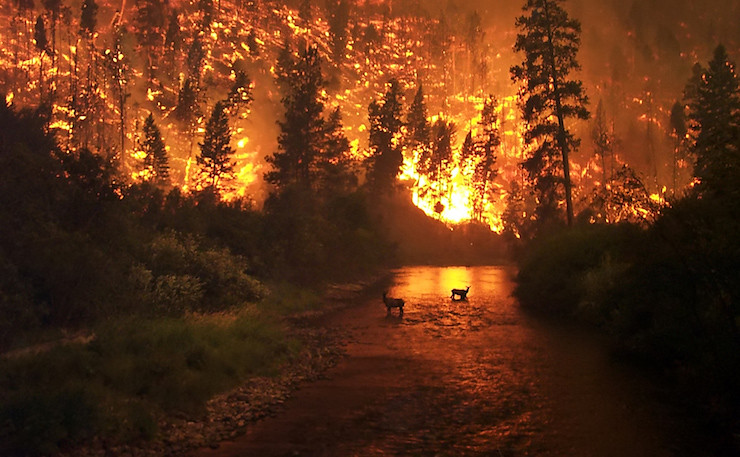The U.S. West is bracing for a potentially record-shattering heatwave through Labor Day weekend, with experts warning that scorching temperatures are likely to trigger a spike in heatstroke and deaths and set the stage for a possibly catastrophic fire season this fall.
Extreme heat—”supercharged” by the fossil fuel-driven climate crisis, as environmental scientist Jonathan Overpeck put it—has been building this week and is only projected to get worse in the coming days.
The National Weather Service in Sacramento has forecast triple-digit highs throughout California’s Central Valley from Thursday until Tuesday. Their counterparts in Los Angeles expect similarly dangerous conditions in southern California from Wednesday through Monday, and even the typically cooler Bay Area is under an excessive heat watch in the coming days.
🥵 Very dangerous heat will bring impacts to interior northern California this #LaborDayWeekend. Plan ahead now for adequate cooling and hydration, especially if you have outdoor plans this holiday weekend! #CAwx
Forecast: https://t.co/WjKBsJDVhA pic.twitter.com/2YANcEC9yD
— NWS Sacramento (@NWSSacramento) August 31, 2022
It’s not just Californians who are at risk. Above-average temperatures are on the horizon in several other parts of the region, from the Pacific Northwest to northwest Arizona, where the mercury is projected to hit eight to 12 degrees higher than usual this weekend.
In many states, temperatures are expected to hover around 80°F overnight, heightening the risk of heat-related illnesses and deaths, especially for unhoused and low-income residents who lack air conditioning or are unable to afford soaring energy costs.
“High temperatures are also expected to accelerate the formation of ground-level ozone, or smog, which exacerbates respiratory issues,” The Guardian reported Wednesday.
In addition, experts are sounding the alarm about how this heatwave “could further prime the parched, drought-addled West for wildfires,” the newspaper noted. So far this year, 48,211 fires have burned more than 6.1 million acres nationwide, which is “well above” the 10-year average, the National Interagency Fire Center reports.
“Because of the last two-plus years of drought, the fuel is ready to go and it’s just a matter of things lining up in terms of weather and ignitions,” Alex Tardy, a warning coordination meteorologist with the National Weather Service in San Diego, told the Washington Post earlier this week.
With the heatwave coming just as windy weather patterns start to increase across the region, “I would be surprised if we don’t get a relatively active fire season in September and October,” he added.
Oregon Gov. Kate Brown (D) declared a state of emergency on Sunday “due to the imminent threat of wildfire.”
“With wildfire behavior increasing across the state, and with the threat of fire not likely to recede in the near future, it is imperative that we act now to prevent further loss—of life, property, business, and our natural resources,” said Brown.
As the Post reported:
This past weekend, a passing cold front drove several thousand acres of growth on Oregon’s Rum Creek Fire, now over 10,000 acres. It also fanned the flames of the Cherry Gulch Fire in northern Nevada, which ballooned from zero to 15,000 acres in less than a day.
“These types of patterns tend to increase as we approach fall,” said Gina McGuire, a fire meteorologist with the Great Basin Coordination Center in Salt Lake City, who noted that dried grasses in northern Nevada into Idaho could fuel rapid fire spread during windy conditions.
There has also been abundant lightning in Idaho in the past few weeks, and holdover fires could still emerge.
“That’s a big concern, especially in our higher-elevation timber areas,” McGuire said. “That’s something that we’re definitely watching, not only with wind but also this week when we get higher temperatures.”
So far, California’s fire season has been relatively less intense compared with recent years. Approximately 200,000 acres have burned across the state to date—less than one-tenth of the 2.2 million acres that had been torched by this time last year and about a sixth of the 5-year average of 1.26 million acres, according to data from the California Department of Forestry and Fire Protection.
In addition, California has yet to experience a 100,000-acre “megafire” in 2022—the kind of calamity that has become commonplace in recent years amid the state’s historic drought and increasingly frequent heatwaves.
All of that could soon change, however, thanks to “extreme or prolonged heat, as well as dry autumn winds,” the Post reported. “California could see its first offshore winds in September, which tend to intensify through the fall and have driven the state’s most destructive fires.”
According to Tardy, “We typically shouldn’t expect July and August to be the biggest part of the season in Southern California. Our time for the bigger fires is coming up.”
Hundreds of millions of people around the world are currently suffering under the weight of oppressively high temperatures. A study published last week found that heatwaves deemed “dangerous” or “extremely dangerous” are set to triple this century unless policymakers move quickly to slash greenhouse gas pollution.
Extreme weather disasters, Los Angeles-based climate scientist Peter Kalmus warned earlier this year, are “guaranteed to worsen every year until we end fossil fuels.”
